THINK ABOUTIT SIGHTINGS REPORT
Date: October 3, 1958
Location: Monon, Indiana, United States
Hynek Classification: NL (Nocturnal Light) Point or extended luminous source observed at night.
Duration: 70 mins
Shape of Object(s): big, round white things
Number of Witnesses: Multiple
Source: Frank Edwards / UFO Casebook Source
Summary: A Monon railroad train crew reported seeing multiple UFOs in north central Indiana. The objects were 40 feet in diameter and about 10 feet thick, and followed the train for over an hour.
Full Report
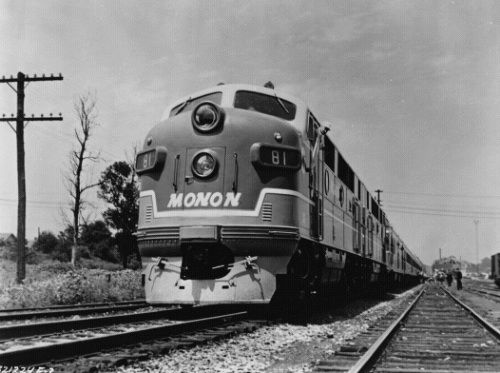
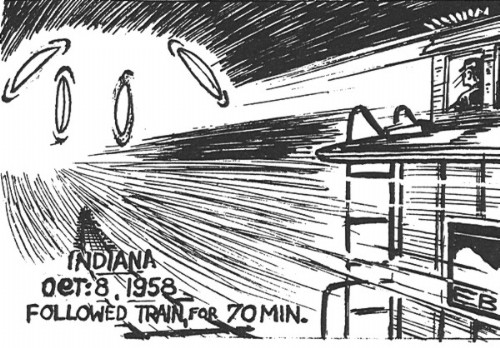
Credit: NICAP / Hall (1964)
1958, The Monon Railroad UFO Incident (Indiana)
A Monon railroad train crew reported seeing a UFO in north central Indiana. It was about 3.20 A.M. on Friday October 3, 1958… freight train no. 91 was enroute southbound from Monon, to Indianapolis.
In the cab of the diesel locomotive were three men – Harry Eckman, the engineer, Cecil Bridge, the fireman, and Morris Ott, the head brakeman. Ed Robinson, the conductor, and Paul Sosbey, the flagman, were in the caboose. Cecil Bridge, the fireman, a former air force man with 450 hours of heavy bomber time, begins the story as follows…
“…we had just pulled past a little spot called Wasco. There’s no town there – just a kind of crossroads. It was there we first noticed four lights in the sky ahead of us. They were moving lights. At first they looked like stars but we realized they weren’t stars because they were moving – we could see that.” “They were moving in a sort of open V formation. By that I mean that there was no light at the forward point of the flight, just the two ‘wings’ with two Lights in each ‘wing’ – angled off at about 45 degrees from each other. I must have spotted them first. After I had watched them for about 15 seconds, I called them to the attention of the other men in the cab with me. They watched the lights, too…”
“About that time the lights veered west. They crossed the tracks ahead of the train – about a half a mile ahead of us, we estimated. They were moving pretty slowly, too, at no more than about 50 miles an hour, four big, white, soft lights.”
“Just the three of us in the engine saw the lights at this time. We were pulling 56 cars – that’s a little more than half a mile of cars – and because of the angle at which these things were approaching and because they were so low right then, the boys in the caboose probably couldn’t see them.” “After the lights crossed the tracks in front of us, they stopped and came back. This time they were headed east. They shot off toward the east and were gone a few minutes – out of sight – but when they came back and we all saw them again, I turned on the microphone. We have radio between the engine and caboose. I told the boys in the caboose what we were watching.”
“…I talked to Robinson, (the conductor), and told him what we had seen. During the time we watched these things, from Wasco to Kirklin, we did a lot of talking on that radio. The dispatcher in Lafayette could hear us, of course, but he never cut in. The boys in the caboose got the best look at the things. Especially when they came right down over the whole train.”
Conductor Robinson continues the story.
“I was sitting in the cupola, looking forward over the train, when Bridge called me on the radio. I had already noticed the four gobs of light but I couldn’t make out what they were. They were half a mile ahead of the caboose – the whole length of the train. A little bit after he called me the things went away and we didn’t see them for a few minutes… then all of a sudden they came back.” “This time they came down over the train, a little way in back of the engine. They were coming toward the caboose. That is, they were going north and the train was headed directly south.”
“I’d say they were only a couple of hundred feet above the train as they came toward the caboose. And they weren’t moving very fast – maybe 30 or 40 miles an hour. It was hard to tell – a fellow just doesn’t notice details like that under the circumstances.”
“The freight train is pretty noisy, of course, but I didn’t hear any other noise, like the roar an airplane would have made. I think they were silent, or nearly silent, at least.”
“They flew over us one after the other – big, round white things that looked about the colour of fluorescent lights, kind of fuzzy around the edges. They didn’t glare and they didn’t light up things as they went over. They just came back toward us, over the top of the cars, one after the other. Then they went on down the tracks maybe another half a mile and seemed to stop.”
“Sosbey and I went out on the back platform where we could see them better, but they were getting pretty far behind us. We could see their lights but I don’t remember whether they were bunched up or not. They were just there, we know that. We could see them behind us, right over the tracks. “Then they swung off away from the tracks and went fast – very fast – to the east. When they picked up speed their light got a lot brighter. They got real bright and white – like stars, but a lot bigger and moving very fast.”
Cecil Bridge, observing the same objects from the engine, describes what he and the engineer and head brakeman saw.
“When these things shot back over to the east of us, they lit up much brighter than they were before. They turned in line, going north or northeast and we noticed that they lit up in sequence – the front one first, then number two, three and four. They changed course and came back past the train. They were going in the opposite direction to us when they made this pass. I guess they were at least a mile or two east of us when they did it.” “They lit up twice (as described above).. First number one would light up, then number two and so on. They did that twice as they went past us travelling in the opposite direction. We noticed, too, that their colour changed. When they first lit up they were bright white but when they slowed down the colour changed to a kind of yellow, then to orange when they went real slow – a kind of dirty orange.”
The conductor, Ed Robinson, agreed with this description. He added:
“We didn’t see them from the back end of the train for several minutes after they went away to the east and turned. But the boys in the engine were still seeing them. I got back on the radio with Bridge. He was watching them right then. They must have circled the train and gone north of us, real low, because the next time we saw them they came rushing up the tracks right in back of us. They were coming a lot faster this time – a lot faster than they had come back over the train the first time.
“They were just above the tree-tops along the right of way, and they had changed their way of flying — their formation. This time they were sort of flying on edge. Two of them were on edge – the two in the middle. The two on the outside were tilted at an angle both in the same direction. The four of them flew like that up the tracks behind the train – a tilted one on the east, two of them straight up and down, then the one on the west tilted just like the one on the east.
“When they first came back over the train we could see that they were round things – circular shaped on the bottom. Then when they flew up the tracks in back of us we could see – Sosbey and I – that they were about 40 feet in diameter and maybe 10 feet thick. The two flying straight up and down were approximately over the edges of the right of way and about 200 yards in back of the caboose. If they had been flying flat down instead of edgewise. They would have just about have touched edges so they must have seen somewhere around 40 feet across the bottom.” Fireman Cecil Bridge continues:
“We had flashlights in the engine and in the caboose. Up on the head end of the train – in the engine where I was –we blinked our flashlights at the things and we waved the lights. We thought we might get them to come in closer. They did come down over the train a few minutes later, as Robinson related, but of course, I can’t say they did it because we flashed the lights at them. At any rate they didn’t flash any lights back at us.” Robinson continues:
“In the caboose we had a five cell sealed beam flashlight that throws a pretty good beam a long ways. When the things came down and flew right up the tracks behind the caboose, I grabbed that sealed beam flashlight and shined it on them. As soon as the light hit them they jumped sideways out of the beam. When they got back over the tracks I did it it again and they scattered. They acted like they didn’t care for that light at all.
“From the time Bridge first called us on the radio until the last time we saw them near Kirklin (38 miles northwest of Indianapolis) it was about an hour and 10 minutes altogether. They hung around the back end of the train but after we shined the light on them they didn’t come in close any more. While we were switching at Frankfort they stayed away back up the tracks, just hovered there, until we moved on. Then they followed us again. When they finally went away at Kirklin, they just zipped off to the northeast and kept on going and we didn’t see them anymore.”
written by Frank Edwards




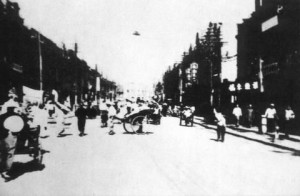
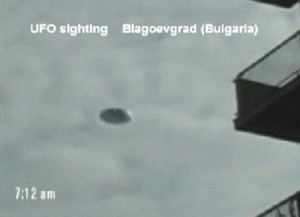
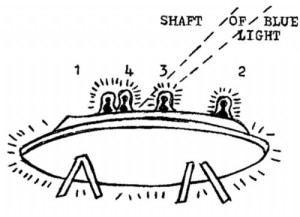
Related Reports
1948: Domed Disc Seen
1957: Object beamed out an eerie, penetrating light
1963: Homer Indiana Landing